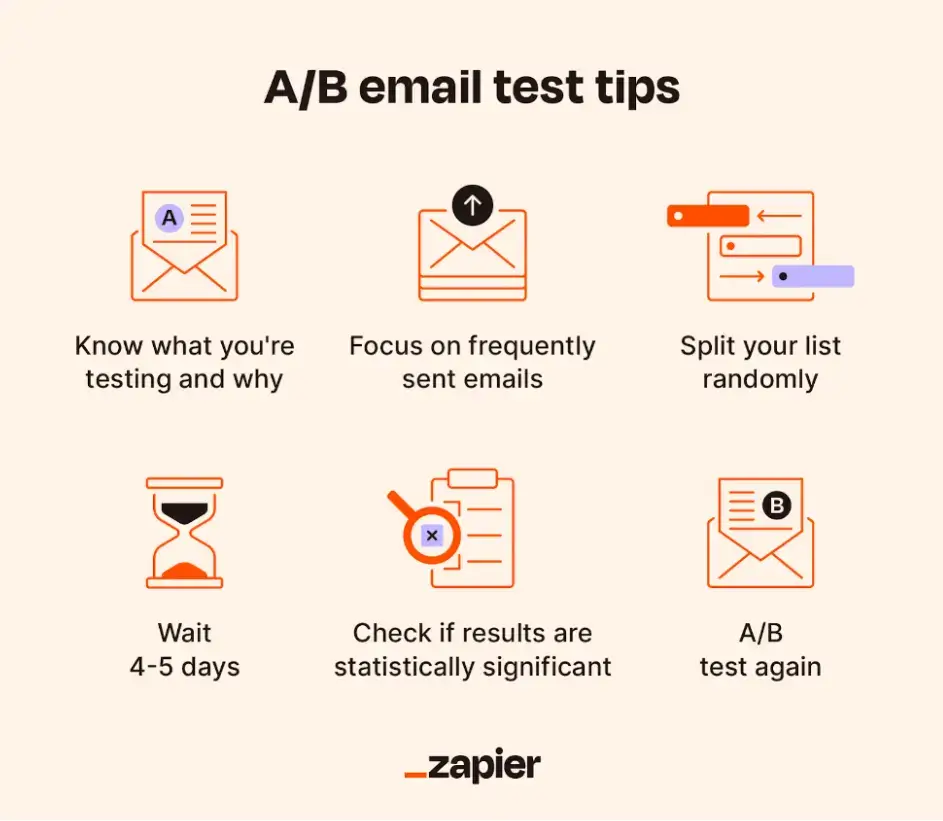In the fast-paced world of digital marketing, email remains a powerful tool for businesses to connect with their audience.
However, sending out emails without analyzing the performance metrics is akin to navigating a ship without a compass.
To optimize your email marketing strategy and ensure its effectiveness, it's crucial to delve into metrics beyond the usual open rates and click-through rates.
Article Shortcuts:
- What is Email Marketing?
- Why is Tracking and Analyzing Emails So Important?
- Email Marketing Metrics Which Are Important To Track
- Ways To Use The Analytics To Improve Your Email Marketing

What is Email Marketing?
Email marketing is a digital marketing strategy that involves sending targeted messages via email to a group of individuals who have opted to receive communications from a business or organization.
It is a direct and cost-effective method for companies to connect with their audience, promote products or services, and foster customer relationships.
The process typically begins with the collection of email addresses through sign-up forms, purchases, or other interactions.
Once a subscriber list is established, marketers use segmentation to categorize recipients based on various factors. This allows for personalized and relevant content.
Effective email marketing involves creating engaging and visually appealing emails, optimizing for different devices, and incorporating elements of personalization.
Automation is often employed to trigger emails based on specific actions or events, enhancing efficiency.
Metrics such as open rates, click-through rates, and conversions are closely monitored to assess campaign performance. This enables marketers to refine their strategies for better engagement and results.
Compliance with regulations, like obtaining consent and providing opt-out options, is crucial to maintaining ethical and legal standards in email marketing campaigns.
Overall, email marketing serves as a versatile and powerful tool for businesses to communicate with their audience and achieve various marketing objectives.

Why is Tracking and Analyzing Emails So Important?
Tracking and analyzing are crucial aspects of email marketing for several reasons. Below are the reasons mentioned:
-
Performance evaluation
Tracking metrics such as open rates, click-through rates, conversion rates, and other relevant data allows marketers to evaluate the performance of their email campaigns.
Understanding how well a campaign is resonating with the audience helps in making data-driven decisions for future strategies.
-
ROI measurement
By tracking the performance metrics, marketers can calculate the Return on Investment (ROI) of their email marketing efforts.
This helps in assessing the effectiveness of the campaigns in terms of the resources invested and the results achieved.
-
Optimization opportunities
Analysis of email campaign data provides insights into what elements are working well and what areas need improvement.
This information can be used to optimize various aspects of future campaigns, such as subject lines, content, design, and timing.
-
Audience insights
Tracking user behavior and engagement levels provides valuable insights into audience preferences and behaviors.
Marketers can use this information to segment their audience more effectively, deliver personalized content, and tailor future campaigns to better meet subscribers' needs and expectations.
-
A/B testing
Tracking allows for A/B testing, where marketers can experiment with different elements of their emails (e.g., subject lines, calls-to-action, visuals) and analyze which variations perform better.
This iterative process helps refine strategies for optimal results.

-
Continuous improvement
Email marketing is an evolving process, and continuous improvement is essential for staying relevant and effective.
Regular analysis allows marketers to learn from past experiences, adapt to changing trends, and refine their strategies over time.
-
Identifying trends and patterns
By tracking and analyzing data over an extended period, marketers can identify trends and patterns in subscriber behavior. This knowledge helps in anticipating future trends and adjusting strategies accordingly.
-
Budget allocation
Understanding which campaigns and strategies are more effective enables marketers to allocate their budget more efficiently.
This ensures that resources are directed towards the most impactful initiatives, improving overall marketing effectiveness.
Email Marketing Metrics Which Are Important To Track
Several key metrics are important to measure and analyze in email marketing to assess the success of campaigns and make informed decisions for optimization. Here are some essential email marketing metrics:

-
Open rate
Definition: The percentage of delivered emails that were opened by recipients.
Importance: Indicates the effectiveness of your subject lines and the overall appeal of your emails.
-
Click-through rate (CTR)
Definition: The percentage of recipients who clicked on one or more links contained in an email.
Importance: Measures the engagement level and the relevance of your content and calls-to-action.
-
Conversion rate
Definition: The percentage of email recipients who completed the desired action, such as making a purchase or filling out a form, in response to an email.
Importance: Reflects the effectiveness of your email in driving the intended outcome or conversion.
-
Bounce rate
Definition: The percentage of sent emails that were not delivered to the recipient's inbox.
Importance: Indicates the quality of your email list and the deliverability of your emails.
-
List growth rate
Definition: The rate at which your email list is growing over a specific period.
Importance: Reflects the health and sustainability of your email marketing efforts.
-
Unsubscribe rate
Definition: The percentage of recipients who opt-out or unsubscribe from your email list after receiving a particular campaign.
Importance: Provides insights into the relevance and frequency of your email content.
-
Forward rate
Definition: The percentage of recipients who forward your email to others.
Importance: Indicates the shareability and perceived value of your content.
-
Revenue per email
Definition: The amount of revenue generated per email sent.
Importance: Connects email marketing efforts directly to business outcomes and helps assess the overall return on investment.
-
Delivery rate
Definition: The percentage of sent emails that were successfully delivered to the recipients' inboxes.
Importance: A key indicator of the deliverability and sender reputation of your emails.
-
Engagement over time
Definition: Tracking how engagement metrics (opens, clicks) evolve over time.
Importance: Helps identify patterns, trends, and the optimal timing for sending emails to your audience.
-
Device and client usage
Definition: Understanding which devices and email clients your audience uses to open and interact with emails.
Importance: Helps optimize email design and content for the devices and clients most commonly used by your audience.
Ways To Use The Analytics to Improve Your Email Marketing
In the dynamic landscape of digital marketing, leveraging analytics is paramount to enhance the efficacy of your email marketing campaigns.
By integrating strategic analytics into your email marketing strategy, you can refine your outreach efforts and positively impact your search engine ranking.
-
Define Key Performance Indicators (KPIs)
Identify the key metrics that align with your objectives. Common KPIs include open rate, click-through rate, conversion rate, and revenue per email. These metrics will serve as benchmarks for evaluating your campaigns.
-
Set clear objectives
Clearly define the goals of your email marketing campaigns. Whether it's increasing sales, driving website traffic, recruiting sponsors, or building brand awareness, having specific objectives will guide your analytics strategy.
-
Regularly monitor metrics
Use an analytics tool to monitor and track the performance of your email campaigns regularly. Pay attention to trends and patterns over time, as this can provide valuable insights into your audience's behavior.
-
Segment your data
Analyze your metrics based on different segments, such as demographics, location, or behavior. This segmentation allows you to identify specific trends and preferences among different subsets of your audience.
-
A/B testing
Conduct A/B tests on various elements of your emails, such as subject lines, content, images, and calls to action. Analyze the performance of different variations to understand what resonates best with your audience.
-
Optimize content and design
Use analytics to identify the content and design elements that perform well. Pay attention to the type of content that generates higher engagement and adjust your future campaigns accordingly.
-
Refine targeting and personalization
Leverage analytics to understand how different segments of your audience respond to personalized content. Refine your targeting strategies to deliver more relevant and personalized emails to specific groups.

Source
-
Address deliverability issues
Monitor your email deliverability metrics closely. If you notice a high bounce rate or a decrease in delivery rates, investigate and address potential issues with your email list quality or sender reputation.
-
Optimize send times
Analyze engagement patterns over time to determine the most effective days and times to send emails to your audience. Adjust your sending schedule to align with when your subscribers are most active.
-
Learn from unsubscribe and complaint rates
Analyze unsubscribe and complaint rates to identify patterns or trends related to specific types of content or campaigns. Use this information to refine your email content and frequency.
-
Iterative improvement
Implement changes based on your digital marketing analytics insights and monitor the impact on your key metrics.
Email marketing is an important part of digital marketing. It is an iterative process, and continuous improvement is key to long-term success.
-
Integrate with other marketing channels
Integrate email marketing analytics with data from other marketing channels to get a holistic view of your overall marketing performance. This can help you identify cross-channel insights and opportunities.
Conclusion
It becomes abundantly clear that a successful email marketing strategy extends far beyond just open rates and click-through rates. The often overlooked metrics discussed in this guide serve as the compass that guides your ship through the vast ocean of digital communication.
By embracing a holistic approach to email marketing metrics, you not only gain insights into your audience's engagement but also uncover opportunities for refinement and growth.
Metrics such as deliverability, conversion rates, and customer lifetime value paint a comprehensive picture of your campaign's performance, enabling you to make data-driven decisions that resonate with your audience.


